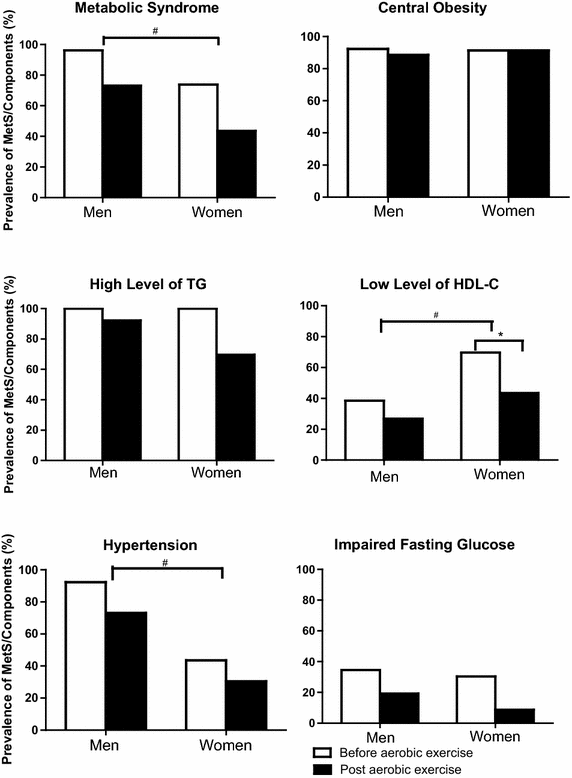Effect of aerobic exercise training on cardiometabolic risk factors among professional athletes in the heaviest-weight class
- PMID: 26388949
- PMCID: PMC4573697
- DOI: 10.1186/s13098-015-0071-y
Effect of aerobic exercise training on cardiometabolic risk factors among professional athletes in the heaviest-weight class
Abstract
Background: High prevalence of metabolic diseases among young professional athletes with large body sizes has raised growing attention. However, few studies specifically examined whether additional aerobic exercise provides cardiometabolic beneficial effect among these young athletes under regularly intensive strength training.
Objective: We conducted a pilot trial to evaluate the effects of aerobic exercise on overall metabolic syndrome (MetS), individual MetS components, and aerobic capacity among metabolically unhealthy athletes in the heaviest-weight class.
Methods: Forty-nine professional athletes aged 15-30 years had large body weights (mean weight of 131 ± 15.5 kg and 108 ± 15.8 kg and mean BMI of 39.4 ± 4.7 kg/m(2) and 36.4 ± 5.1 kg/m(2) for 26 men and 23 women, respectively). They completed a supervised moderate intensity (maximal heart rate: 140-170 beats/min for 30-70 min/day) aerobic exercise training for 12 weeks. We collected and measured metabolic parameters and aerobic capacity for all participants before and after 12 weeks of aerobic exercise training.
Results: At baseline, 42 (86 %) of all 49 metabolically abnormal athletes were diagnosed as MetS according to the NCEP ATP III criteria (≥3 MetS components). After aerobic exercise training, 30 % (13/42) of MetS individuals tended to become free of MetS (<3 MetS components), decreasing the prevalence of MetS by 30.4 % (from 17 to 10) in women and 23.1 % (from 25 to 19) in men (P = 0.001). All individual components of MetS, including fasting glucose levels, lipid profile, and blood pressure, were also significantly improved (all P-values <0.05). Overall and central obesity indexes, including BMI, waist circumference, Waist-hip ratio, and abdominal fat ratio, were significantly decreased in men whereas only overall adiposity indexes, such as BMI and body fat percentage, were significantly reduced in women. Also, participants' aerobic capacities were also significantly enhanced with longer running distances and decreased heart rates (all P-values <0.05).
Conclusions: Our pilot trial showed that moderate intensity aerobic exercise effectively improved cardiometabolic parameters in metabolically unhealthy professional athletes with routinely intensive strength training. Its long-term cardiovascular effects will be evaluated by future randomized controlled trials with well-designed exercise modalities.
Keywords: Aerobic exercise; Athletes; Cardiometabolic risk factors; Metabolic syndrome.
Figures

Similar articles
-
Efficacy of morning versus afternoon aerobic exercise training on reducing metabolic syndrome components: A randomized controlled trial.J Physiol. 2024 Dec;602(23):6463-6477. doi: 10.1113/JP285366. Epub 2023 Nov 28. J Physiol. 2024. PMID: 38015017 Free PMC article. Clinical Trial.
-
Prevalence of metabolic syndrome and its components among Chinese professional athletes of strength sports with different body weight categories.PLoS One. 2013 Nov 8;8(11):e79758. doi: 10.1371/journal.pone.0079758. eCollection 2013. PLoS One. 2013. PMID: 24255714 Free PMC article.
-
The Effects of Concurrent Training Combining Both Resistance Exercise and High-Intensity Interval Training or Moderate-Intensity Continuous Training on Metabolic Syndrome.Front Physiol. 2020 Jun 11;11:572. doi: 10.3389/fphys.2020.00572. eCollection 2020. Front Physiol. 2020. PMID: 32595518 Free PMC article.
-
Aerobic, resistance or combined training: A systematic review and meta-analysis of exercise to reduce cardiovascular risk in adults with metabolic syndrome.Atherosclerosis. 2018 Jul;274:162-171. doi: 10.1016/j.atherosclerosis.2018.05.002. Epub 2018 May 3. Atherosclerosis. 2018. PMID: 29783064
-
Effect of aerobic interval training on exercise capacity and metabolic risk factors in people with cardiometabolic disorders: a meta-analysis.J Cardiopulm Rehabil Prev. 2011 Nov-Dec;31(6):378-85. doi: 10.1097/HCR.0b013e31822f16cb. J Cardiopulm Rehabil Prev. 2011. PMID: 21946419
Cited by
-
Menstrual blood loss as an initial trigger for adaptation of iron metabolism in eumenorrheic female athletes-An exploratory study.Physiol Rep. 2025 Aug;13(16):e70522. doi: 10.14814/phy2.70522. Physiol Rep. 2025. PMID: 40856157 Free PMC article.
-
Effects of aerobic, resistance, and combined exercise training on body fat and glucolipid metabolism in inactive middle-aged adults with overweight or obesity: a randomized trial.BMC Sports Sci Med Rehabil. 2024 Sep 11;16(1):189. doi: 10.1186/s13102-024-00982-7. BMC Sports Sci Med Rehabil. 2024. PMID: 39261968 Free PMC article.
References
-
- National Institute for Occupational Safety and Health. NFL Mortality Study. http://www.cdcgov/niosh/pdfs/nflfactsheetpdf. Accessed 1 Sep 2008.
Grants and funding
LinkOut - more resources
Full Text Sources
Other Literature Sources

